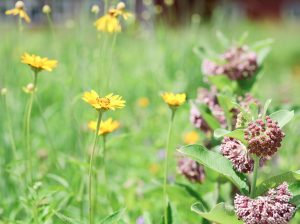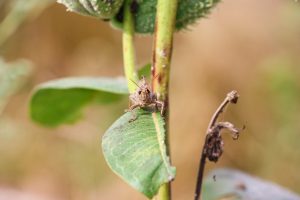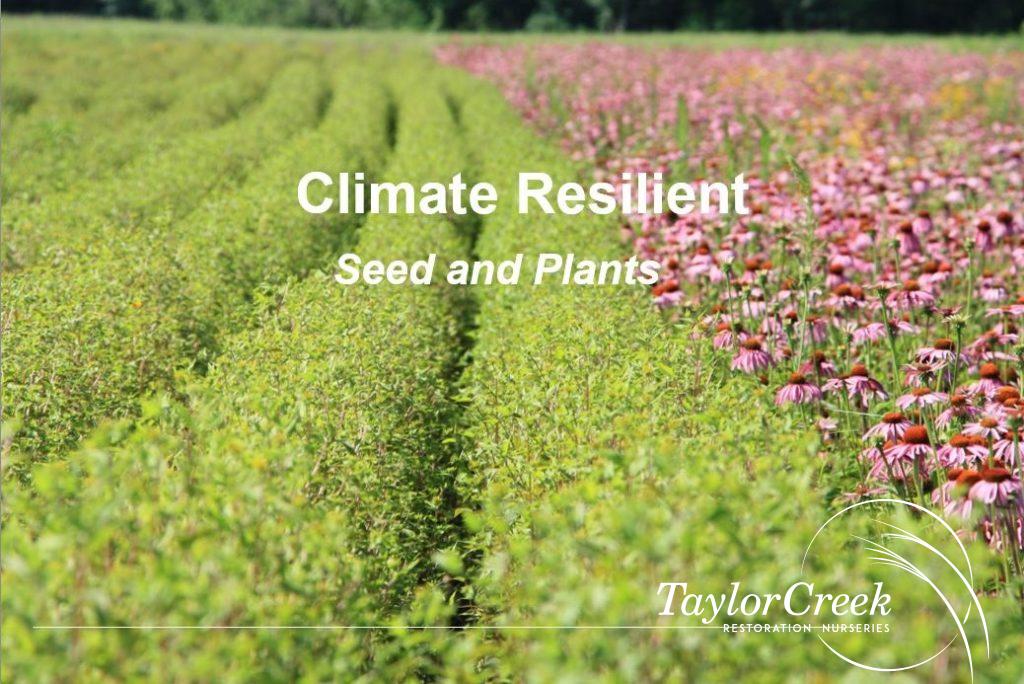Growing Philosophy
As restoration horticulture professionals, we understand that we are growing more than seed and plants – we are growing mindsets. We are helping our many diverse clients restore health to the land through the deliberate use of native plants.
It is not a surprise, therefore, that we have adopted the motto—used for many decades by the medical profession—first, do no harm.
This is not always easy. We are continually aware of the need to perpetuate the health of the soil and water of our own production lands while we also support the pollinators and other animals using these lands.
All while, we must maintain price points that allow us to remain competitive as a business.
To accomplish these interconnected objectives, we minimize the use of pesticides. Moreover, we are committed to avoiding the use of neonictinoides (neonics) that have been shown through scientific studies to be highly detrimental to bees and other pollinators.
 “Near-Wild Type” Is the Responsible Choice
“Near-Wild Type” Is the Responsible Choice
Right along with knowledgeable native plant enthusiasts, Taylor Creek Restoration Nurseries maintains that native seed should be purchased only from licensed producers who grow native plants and seed under cultivation. Native plants propagated under cultivation from original wild sources are known in the business as “near-wild types.”
But that raises a fundamental question: How does Taylor Creek begin its cultivated seed and plant production in the first place?
Responsible growers such as Taylor Creek Restoration Nurseries begin with small quantities of seed which are hand collected from healthy remnant wild populations. Those small hand-collected seed lots are then grown into hundreds of plants in a nursery setting. These plants are subsequently set into fields for further amplification. (Amplification simply means growing a second generation of seed, which then will be grown into tens of thousands of plants for seed production.)
Growing plants under cultivation unavoidably involves loss of genetic diversity. Thus, despite our best efforts, it is the “most average” plants that make the cut in the long run. And this results in losing some of the diversity that characterizes a healthy wild population.
We limit loss of population genetic diversity by restricting the number of “plant-generations- removed” from wild-type origin that characterize our production fields at the time of harvest.
In addition, we “re-infuse” our production fields with new material that is as near to first generation as is feasible. This best practice helps Mother Nature hedge her bets against disease, climate change, and other unpredictable challenges to production.
Take Care of the Wild
Taylor Creek Restoration Nurseries is committed to caring for wild remnant populations.
Out of necessity our fields were established from small amounts of seed collected from remnant populations, so, in a very real way, we feel we owe these plant communities a debt.
As part of our contracts with landowners (and in a very real sense, with the land itself) we carefully monitor and maintain the health of these remnants. We have a team of specialists whose first charge is managing the health of these areas using actions such as invasive species management, prescribed burning, and brushing. And we take great care to avoid over-collecting seed on these sites. Once again, we strive to “do no harm.”
Local Genotype: The Difference that Sets Us Apart from the Competition

What is local genotype—and why does it matter?
Native merely means a species was present in a geographical region before the modern settlement of an area. It is a geographical and historical definition. It is a broad-brush definition meant to exclude species brought from Europe, Asia, or some far-away state.
Local genotype means that a population of plants has been growing in a very specific region over many generations. The conditions of that area (climate, soil, presence of other plant and animal species, etc.) have all influenced which individual plants thrived and produced seed for future generations.
This is an important distinction. Imagine you live in Minnesota and want native wildflowers and grasses in your restored pasture. You know something about native plants and thus take care to choose species that are native to Minnesota.
But…and this is a big but…your chosen vendor is selling a genotype from Texas. If you use seed from that source, many individual plants may not survive a long, harsh Minnesota winter, or a late spring. In yet other scenarios, a displaced genotype that lacks the competition it evolved with may do “too well” and take over a site. Selecting a local genotype minimizes these issues.
Plants from a specific area have been genetically adapting to growing conditions over literally thousands of years. In our production, we take it a step further: we collect seeds from multiple local sites within that larger local genotype area to ensure that additional levels of diversity and adaptation are included in our stock.
Local Genotypes in the Face of Climate Change
Is a local genotype still the best choice in the face of a changing climate?
Or, phrased another way: Should we help nature by moving native plant communities based on modeling predictions on the effects of climate change?
Should we, for example, plant southern genotypes at locations further north to accommodate hotter, longer summers?
It may surprise you to learn that in general, we at Taylor Creek say “no” to this strategy.
Precipitation and humidity combined with temperature are major forces shaping native populations and communities. True. But, and this is a big but, photoperiod—the hours and minutes of daylight—is a much greater force at play. It is photoperiod that triggers plant activity in many species and even dictates when seeds will germinate. In addition, many specialized pollinating insects are photoperiod sensitive. We believe that breaking plant-pollinator relationships presents very real risk to long-term population health. No amount of climate change will alter the time of sunrise and sunset.
In addition, climate change itself is known to increase volatility in the very parameters of storm intensity and temperature waves that the models are trying to predict. This makes it hard to come up with the best solutions, and impossible to accurately predict final results from moving plants between local genotype areas.
For the most part, the horticulturalists at Taylor Creek Restoration Nurseries believe that Mother Nature generally gets this right. When it comes to moving plants and animals around the globe, we humans have very often gotten it wrong when we try to second guess nature.
In short, at Taylor Creek, we’re banking on Mother Nature. And we remain committed to local genotypes.
We Are at Your Service!
- We at Taylor Creek are committed to you—our customer—as the fundamental base of our Growing Philosophy.
- We are committed to recommending and delivering the best products for your needs at the right time.
- We are tenacious. If we don’t carry the product you need, we will work with you to procure the best product for your purposes—and do so without your having to break the bank.
- Finally, we only succeed only if our clients and their projects succeed.
Call or email us today to discuss your native plant needs.

